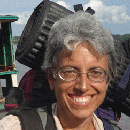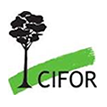How will the Democratic Republic of Congo’s (DRC) greenhouse gas emissions evolve as the country implements its commitments under the Paris Agreement? How does that scenario compare to business-as-usual? And what does that really look like on the ground?
A new interactive digital tool, SimDRC, brings the country a step closer to answering these questions. This platform allows planners to project carbon emissions under different deforestation scenarios, offering greater flexibility in determining how best to meet the country’s climate commitments, known as its Nationally Determined Contribution (NDC).
With SimDRC, users can compare a business-as-usual scenario with one based on NDC targets, which are updated regularly as commitments evolve. The tool joins similar platforms developed for Peru and Brazil as part of the Global Comparative Study on REDD+ (GCS REDD+) led by the Center for International Forestry Research and World Agroforestry (CIFOR-ICRAF). Developed by researchers at the Federal University of Minas Gerais (UFMG) and the Centre for Territorial Intelligence, SimDRC enhances the ability of policymakers to make informed decisions.
“By simulating different scenarios based on specific needs, planners can gain valuable insights for policy formulation and sustainable forest management,” said Richard Van der Hoff, a professor at UFMG
involved in the tool’s development. “Our goal is to help them estimate the effort required to meet NDC commitments and explore the impact of different deforestation patterns on emissions from land-use change and the forestry sector. This will contribute to better conservation planning and more effective sustainable forest management.”
A comprehensive modelling approach
SimDRC is built on a model incorporating a wide range of environmental and socio-economic characteristics, including hydrography, terrain elevation, soil, vegetation, biomass, tree cover, forest loss, temperature, precipitation, population density, protected areas, timber and mining concessions and infrastructure such as mines, railroads, roads and settlements.
Users can generate projections based on three scenarios.
The first, a “business as usual” model, establishes a baseline against which emission reductions can be measured in relation to the Paris Agreement. Under this scenario, the DRC’s NDC commits to reducing overall emissions by 21% and land-use change and the forestry sector by 28% by 2030, relative to its baseline. Deforestation is projected to increase from 852,000 hectares in 2021 to over 1.1 million hectares in 2030.
A second business-as-usual scenario uses the five-year average deforestation rate for 2016-2020 to develop projections for 2021-2030. Under this scenario, deforestation is predicted to hold steady at approximately 639,000 ha.
The third scenario, based on the NDC and known as the Regional Low Emission Rural Development Strategies, anticipates a slower rise in deforestation, increasing from 613,000 hectares deforested in 2021 to 832,000 hectares by 2030.
In each case, users can adjust deforestation projections down to the district level, a critical feature given that the drivers of deforestation vary across different regions of the country.“That is especially important”, said Van der Hoff, “because the drivers of deforestation vary in different parts of the country”.

Deforestation near Yangambi, DRC. Photo by Axel Fassio / CIFOR-ICRAF
Understanding deforestation dynamics
The DRC accounts for the largest share of forest loss in the Congo Basin, which spans six countries. Between 2001 and 2020, approximately 11 million hectares of forest were cleared, according to a study by Van der Hoff and his colleagues.
“While small-scale shifting agriculture is widely cited as the primary driver of deforestation, fluctuations in deforestation rates highlight the importance of understanding location-specific drivers,” said Van der Hoff.
For instance, infrastructure development— such as new mines — can attract job seekers, who then settle and engage in farming, leading to increased forest loss. Meanwhile, in conflict zones in the eastern part of the country, deforestation may occur when people displaced by violence move to new areas. Large-scale agriculture and timber concessions may also drive migration patterns, changing settlement and deforestation patterns.
The DRC’s NDC assumes that ongoing conflicts will be resolved; however, such geopolitical uncertainties remain beyond the control of forest planners. With SimDRC, they can account for forest loss locally and make more accurate projections of deforestation and greenhouse gas emissions. “In the future”, Van der Hoff said, “SimDRC could be modified to include other elements.”
“The benefit of this tool is that if policymakers want to upgrade and make improvements, it will be adaptable,” Van der Hoff said. “But that’s for future work. For now, the important thing is that there is a tool available that policymakers can work with.”
Acknowledgements
This work was carried out as part of the Center for International Forestry Research’s Global Comparative Study on REDD+ (www.cifor.org/gcs). The funding partners that have supported this research include the Norwegian Agency for Development Cooperation (Norad, Grant No. QZA-21/0124), International Climate Initiative (IKI) of the German Federal Ministry for the Environment, Nature Conservation and Nuclear Safety (BMU, Grant No. 20_III_108), and CGIAR Research Program on Forests, Trees and Agroforestry (CRP-FTA) with financial support from CGIAR Fund Donors
We want you to share Forests News content, which is licensed under Creative Commons Attribution-NonCommercial-ShareAlike 4.0 International (CC BY-NC-SA 4.0). This means you are free to redistribute our material for non-commercial purposes. All we ask is that you give Forests News appropriate credit and link to the original Forests News content, indicate if changes were made, and distribute your contributions under the same Creative Commons license. You must notify Forests News if you repost, reprint or reuse our materials by contacting forestsnews@cifor-icraf.org.













